The Best Games We Played At PAX East 2024 (original) (raw)
The videogame industry is not doing great at the moment. Rampant layoffs continue, particularly at irresponsibly run holdings companies (apparently, devs call this effect getting “Embracer-ed”). In some ways, this was felt on the show floor at this year’s PAX East, as the bigger publishers were largely absent, possibly to reduce spending. It also didn’t help that this year’s Game Developer’s Conference (GDC) overlapped with the show, a fact seen in many a bleary-eyed PR rep forced to hop from one coast to the next.
But despite all this, PAX East 2024 still had an overwhelming number of interesting games. There were so many that even if you were to frantically rush between booths in an attempt to play them all, you still wouldn’t even come close to getting hands-on with everything worth seeing. I know this because that is what I did for much of the show, and as a result, I saw quite a bit of what the convention had to offer. These 10 stood out to me the most and are now safely tucked away on my Steam wishlist.
My Familiar

Fans of independently-produced turn-based RPGs continue to feast, and the latest course in the buffet is the colorful My Familiar. You play as a kid who, in the words of one of its creators, gets “isekai-ed” after getting hucked from a window. After meeting this grisly end, they’re reborn in a world full of talking animals who look like they crawled out of a back alley on Sesame Street. The only way back home is to climb a mountain that hasn’t been scaled in ages; a journey made tougher because the oppressive powers keep others from scaling its heights. Colorful pixel art and ‘90s-infused weirdness combine with witty writing to produce something similar but distinct from AlphaDream’s Mario & Luigi series. Just like those games, this one uses timing mechanics during turn-based encounters, allowing you to deal additional damage if you land your input at the right moment. A nice twist on this is that depending on how precise you are, you’ll receive different stages of damage multipliers, much like a rhythm game. You can also utilize special attacks that expend SP (the equivalent to mana in other RPGs), which is frequently worth doing because these moves deal additional damage and can sometimes even bump foes back in the turn order. Tying it all together is a general visual flair embodied in the flashy UI, creative sprites, and specificity of this dream world, demonstrating a level of polish that’s unusual for this kind of show floor demo. Oh, and according to the dev I talked to, it won’t be a million hours long (instead, it will be somewhere in the 15-20 hours range), making it a nice alternative to the massive time-sucks that usually define the genre.
Pipistrello and the Cursed Yoyo
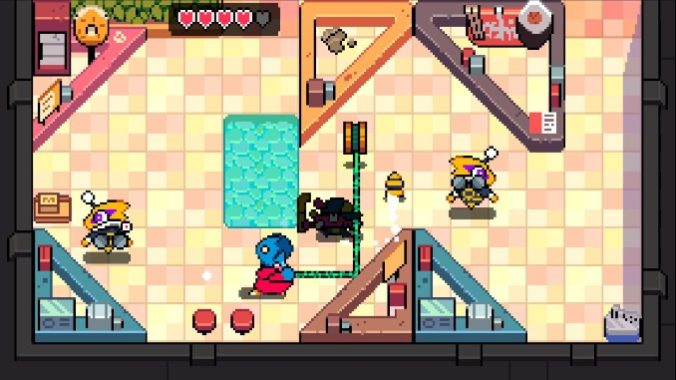
Sometimes, it only takes a minute or two of moving around in a game to suspect it will rule. That was very much my experience with Pipistrello and the Cursed Yoyo, a top-down action-adventure title that at least partially follows in the footsteps of the old-school Legend of Zelda. But instead of being armed with a trusty Master Sword, you wield a hyper-powered yoyo, a tool that lets you zoom through these screens with freeform fluidity. You can do normal videogame things like jump or parry, but the yoyo is what makes things novel. It can be used to Walk the Dog and propel yourself forward, latch onto surfaces, boost off of terrain, and give baddies the beat down. Most impressively, these movements can be chained together, letting you knock into a wall and change your angle mid-air to fly over a chasm. When it comes to battles, there’s an equal number of moves at your disposal, but my personal favorite is how you can bounce the yoyo off corners to extend its range, each deflection punctuated by an ascending pinball-like chirp as it smacks into foes on the other side of the map (this is very satisfying). The world is laid out in a somewhat open-ended fashion, meaning you frequently have multiple paths to explore at the same time, which is something you’ll want to do so you can test out the previously mentioned techniques. Visually, Pipistrello is deeply inspired by the blocky sprites of Game Boy Advance releases, sporting colorful pixel art and a particular animation style that reminds me of that handheld in the best way possible. I knew nothing about this one going into the convention, but its yoyo platforming has more than caught my attention, placing it near the top of my most anticipated list.
Sorry We’re Closed
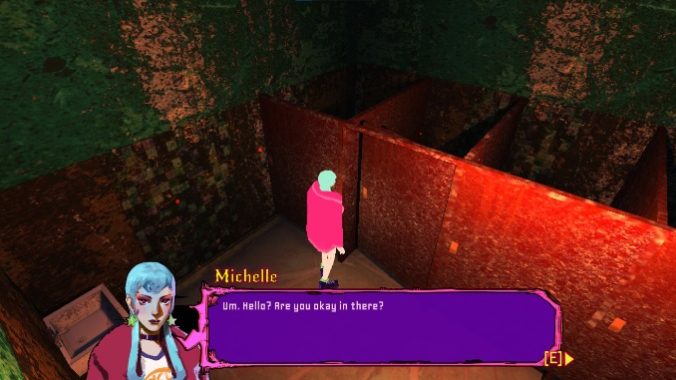
We all have a type, and mine happens to be games styled after fixed-camera angle survival horror of the mid-’90s to early 2000s. Sorry We’re Closed very much falls into this camp. But even accounting for this bias, the game feels like it’s offering a fresh spin on this premise. The boldness of its look is the first thing that caught my eye, and the colorful fashion designer fits inspired by queer culture contrast with the harsh browns of rusting metal, resulting in a mixture of industrial grime and neon. You play as Michelle, a woman still reeling from a breakup with her ex-girlfriend, who’s cursed by a demon and forced to travel into a world of giant rats and cleaver-dragging monsters. While its fixed camera angles deliver all the juicy claustrophobia and striking framing you would want from this presentation, an interesting departure from many of these older titles is that things shift to first-person when you take a combat stance. You also have an ability called the Third Eye, which can stun opposing creatures and expose their weak points. Although all this sounds empowering, the Third Eye can only be activated point blank, meaning you’re incentivized to get up close and personal with hideous foes as you frantically try to land an attack before they recover from being stunned. Unrelenting sound design adds to the scares, as scraping, scratching, and footsteps make you feel stalked from all sides. Thankfully, you get occasional reprieves from this anxiety in the form of time outside the demon world, which shines thanks to some sharp dialogue and characterization that conveys our protagonist’s relationship problems. While there are plenty of survival horror throwbacks these days, _Sorry We’re Closed_’s norm-defying spin distinguishes it from the pack and has made me eager to see more.
Memory’s Reach
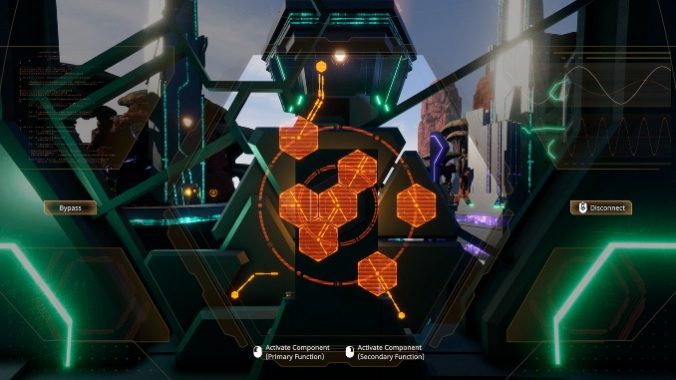
While Metroid-mania has swept across the indie space and created a boom of 2D platformers about collecting items that allow you to traverse deeper into labyrinthine spaces, few, if any, seem to lift from Metroid Prime specifically. Memory’s Reach, a first-person experience where you explore a 3D space, looks to fill this gap, letting you piece together the secrets of an abandoned alien world. However, instead of mimicking Samus Aran and her xeno-blasting tendencies, this experience is entirely focused on solving puzzles, and from what I played, these were appropriately clever. First, I had to align glowing circuity on holographic panels, a process that had me scratching my chin before everything snapped into place. Then, things took on even more complexity as I maneuvered to the exit, using elevators and floating blocks in a correct sequence to make my escape. This exploration was marked with a fitting sense of otherness, as mysterious architecture and scannable terrain offered clues about this far-flung setting. There’s nothing new under the sun, but it’s always cool when a developer riffs on a weirdly underutilized format (in this case, 3D Metroid), and _Memory’s Reach_’s emphasis on flexing your brain instead of a trigger finger helps differentiate it from its point of inspiration.
Fraymakers

Legend has it that to this day, countless little freaks still huddle around the phosphorescent glow of CRTs, taking a certain 20-year-old party/fighting game to new extremes as they melt finger cartilage amidst the click-clacking of GameCube controllers. For those not in the loop on my obscure allusions, I’m referring to Super Smash Bros. Melee, which many players continue to love for its near-unparalleled depth. While Fraymakers isn’t the first platform fighter to take inspiration from Melee specifically, it seems to be doing an excellent job emulating much of what made that singular installment so unique and interesting. There are plenty of advanced techniques (like wavedashing) for the oldheads, as well as new ones like an airdash, but _Fraymaker_’s overlap with other Smash entries makes it easy to pick up and play for those who don’t want to spend the rest of their life practicing shield drops. Lovingly hand-animated pixel art gives the roster, which includes crossover characters like the Watcher from Slay the Spire and Octodad, the proper amount of oomph and ensures it is satisfying to slam your friends into the kill zone. The game is currently in Early Access, and although its official release is still a way off, the core systems and seemingly robust tools for player-generated mods make this one quite promising. It’s always a good sign when you repeatedly return to the same booth on a packed show floor, and Fraymakers passed this test with gusto.
Animal Well
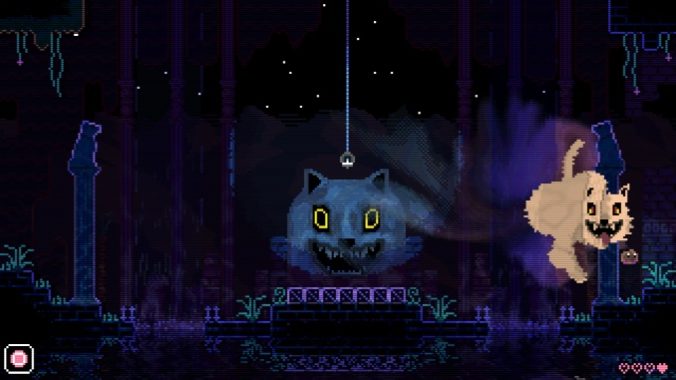
_Animal Well_’s setting is nothing short of hypnotizing. This subterranean wonderland is defined by iridescent pixel art and a cadre of strange creatures, a dreamlike haze vivisected by scanlines. Ancient architecture lingers as ecology beyond your understanding swirls in the background. The chiptune soundtrack echoes as if diegetically reverberating off cave walls, pulling us deeper into the embrace of this place. One of the most compelling details is that you play as a gloopy ball with shoes that mostly cannot fight back against aggressors, such as the cat from Hausu, who really wants to kill you. This lack of traditional combat makes clear that this experience is about unraveling the mysteries of this space, piecing together puzzles in a nonlinear order to journey deeper into these caverns. While there are plenty of identifiable pieces of inspiration at work here—a dash of Metroid-adjacent exploration, a sprinkle of Ghibli films, and a solid heaping of _Fez_’s enigmatic ethos—_Animal Well_’s specific ambiance, lack of battles, and emphasis on piecing together seemingly inscrutable surroundings make it feel distinct. I can’t wait to dive back into these depths.
Fallen Aces
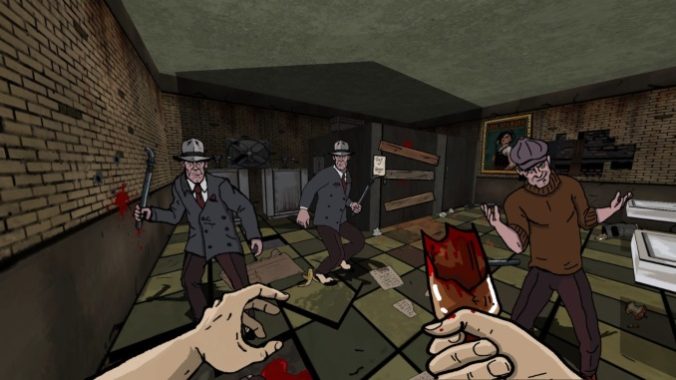
You know the drill for immersive sims: do you enter through the front door as a gun-toting meathead from an action romp or sneak in through a back window like a dagger cutting through the dark? Fallen Aces, a pulpy noir thriller with a comic-book look, is very much in this vein. Thankfully, it seems to be hitting these beats just right, offering enough freedom to feel satisfying. I bob and weave back through doors and alleys as I pick up small context clues on how to make my way in this open-ended level, my slowly dwindling health bar a convincing incentive to take the stealthy approach. However, unlike many games in this genre that make you feel guilty when things go loud, either narratively or because combat doesn’t feel good, neither was the case here. Your adversaries are cartoon gangsters from the ‘40s, so there’s less remorse when smacking them with a crowbar. And there’s a chunkiness and depth to the first-person fisticuffs, which are bolstered by satisfying feedback and defensive mechanics like blocking and parries. While it’s tough to fully evaluate this one because immersive sims truly thrive from the complexity and tools that often come with progressing deeper into the experience, Fallen Aces definitely has the basics down.
Buckshot Roulette
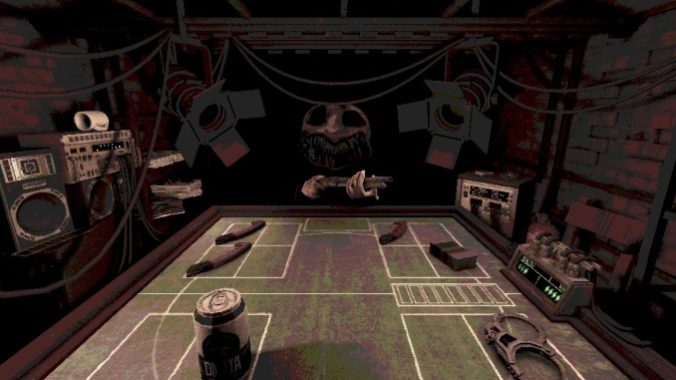
“Now, me and you, we are dancing on the edge of life and death,” the nightmarish dealer says, their jagged teeth and hollow eyes peering through the abyss-like reaches of this gambling den from hell. Simply put, Buckshot Roulette is a horror-tinged game of chance where you do exactly what the title implies: play Russian roulette with a pump-action shotgun. Each round, a varying number of blanks and live rounds are loaded, and you take turns with the dealer pulling the trigger on yourself or your opponent. If you shoot yourself with a blank, you get another turn. But if you blow your own head off, figures emerge from the shadows to defibrillate you back to life (as long as you have health points, that is). From here, additional layers of complexity come into play that make this more than a simple question of probability: you get items that let you do things like look in the chamber to see the next shell, double up on damage, skip your opponent’s turn, etc. It makes for an engaging take on the highest form of gambling there is, one where your life is on the line. And it can’t be overstated how wonderfully grungy the vibe is, the washed-out color palette and murky, lo-fi graphics making this blood sport all the more dismal to behold. While the current version of the game on Itch.io is quite short (you play three matches against the dealer to win), the upcoming Steam release will apparently add some much-requested features to expand things. Between its snuff presentation and surprisingly complicated gun-based gambling, Buckshot Roulette is a blast.
Olliefrog Toadskater
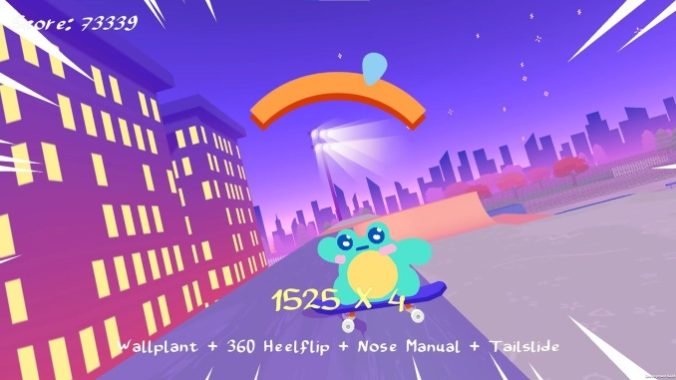
Hey, guess what? Tony Hawk Pro Skater is a very good videogame. And it turns out that when you translate all the underlying mechanics and core feel of those games and then combine it with a charming frog mascot, that’s a pretty solid recipe for success. While I imagine that’s dramatically more difficult to achieve in practice than in theory, Olliefrog Toadskater seems to be pulling it off. So much so that if you’re familiar with the works that inspired it, you can immediately start shredding, using manuals to link together long sequences with flip kicks, vert ramp tricks, and grinds until you’ve racked up a nice combo. Or you can do what I did in front of a crowd of onlookers and repeatedly get greedy until finally eating dirt. Thankfully, if you wipe out, the frog ragdolls adorably in concert with a tiny squeaky toy sound, which caused the people behind me to yell, “Cute!” as the poor little guy paid the cost for my hubris. Tony Hawk (the game, not the man) is dead, but luckily, this green guy is here to provide some arcade skating goodness for those of us who’ve been craving it.
Demon Spore
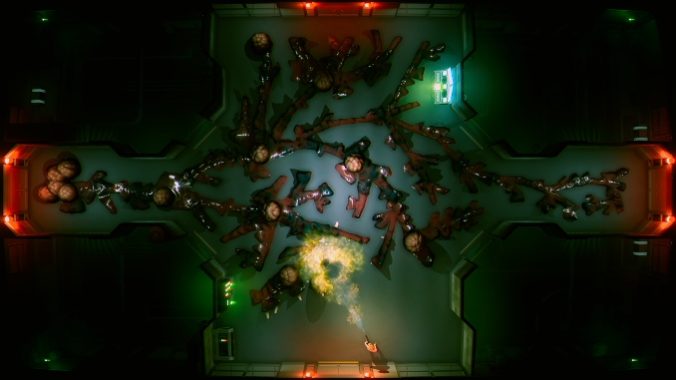
If there’s something about Demon Spore that caught my eye, aside from its loving references to Carpenter and Cronenberg-esque body horror, it’s how the malignant growth at the center of this experience moves. It expands in mesmerizing fractal patterns that cut off escape routes, leaving you holed up in a meeting room where you make a desperate last stand, firing every spare round into the fleshy mass as the end comes. This twin-stick shooter with a roguelike structure works because it conveys you’re up against a near-unstoppable monster that’s slowly, inevitably coming for you. Trapped in a research station where an experiment has gone wrong, you must shoot your way out as you navigate a maze of rooms with the growth hot on your tail. On top of using weapons like a fire extinguisher to slow it down or flames to burn it, you can use furniture to distract or block its offspring from your path as you fight your way to the exit of each area and scrounge for supplies. _Demon Spore_’s shooting feels quite good, but its most impressive feat is making you feel like the unfortunate protagonist of a monster movie just waiting to bite it.
Elijah Gonzalez is an assistant Games and TV Editor for Paste Magazine. In addition to playing and watching the latest on the small screen, he also loves film, creating large lists of media he’ll probably never actually get to, and dreaming of the day he finally gets through all the Like a Dragon games. You can follow him on Twitter @eli_gonzalez11.